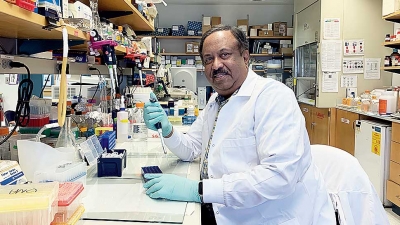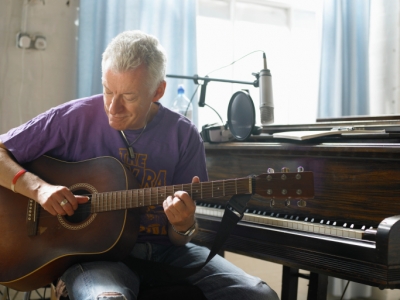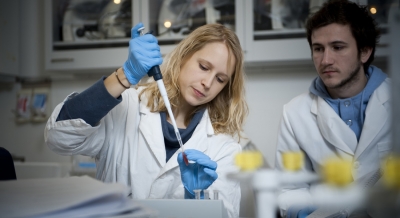
These are tales not just of perseverance and love for science, but also of discrimination and unfair treatment. Despite making groundbreaking discoveries, their names remain largely unknown, simply because they are women. Let's celebrate these women scientists and their contribution to the world….
ESTHER MIRIAM ZIMMER LEDERBERG (1922-2006)
Esther Miriam Zimmer Lederberg was an American microbiologist, who discovered bacterial virus Lambda phage and the bacterial fertility factor F (F plasmid). Like many woman scientists of her time, Esther Lederberg was not given credit for her scientific contribution because of her gender. While her husband, her mentor and another research partner won 1958 Nobel Prize in Physiology or Medicine for discovering how genetic material is transferred between bacteria, Esther wasn't even mentioned in the citation, even though her work significantly contributed to the discovery.
Esther Miriam Lederberg was born in Bronx, New York, into a humble family. When studying masters in genetics at Stanford University, Esther struggled to make ends meet. As recollected by Esther in her interviews, she had sometimes eaten frogs’ legs leftover from laboratory dissections.
Esther met her future husband Joshua Lederberg at Stanford. They moved to the University of Wisconsin, where they would begin years of collaboration. Throughout the 1950s, they published papers together and apart, as both made discoveries about bacteria and genetics of bacteria.
Esther Lederberg's contributions to the field of microbiology were enormous. In 1950, she discovered the lambda phage, a type of bacterial virus, which replicates inside the DNA of bacteria. She developed an important technique known as replica plating, still used in microbiology labs all over the world. Along with her husband and other team members, she discovered the bacterial fertility factor.
CECILIA PAYNE-GAPOSCHKIN (1900-1979)
Cecilia Payne-Gaposchkin was a British-born American astronomer who was the first to propose that stars are made of hydrogen and helium.
Cecilia Payne was born in 1900 in Buckinghamshire, England. In 1919, she got a scholarship to study at Newnham College, Cambridge University, where she initially studied botany, physics, and chemistry. Inspired by Arthur Eddington, an English astronomer, she dropped out to study astronomy.
Studying astronomy at Cambridge in the 1920s was a lonely prospect for a woman. Cecilia sat alone, as she was not allowed to occupy the same rows of seats as her male classmates. The ordeal did not end there. Because of her gender, Cecilia was not awarded a degree, despite fulfilling the requirements in 1923. (Cambridge did not grant degrees to women until 1948.)
Finding no future for a woman scientist in England, she headed to the United States, where she received a fellowship to study at Haward Observatory. In her PhD thesis, published as Stellar Atmospheres in 1925, Cecilia showed for the first time how to read the surface temperature of any star from its spectrum. She also proposed that stars are composed mostly of hydrogen and helium. In 1925, she became the first person to earn a PhD in astronomy. But she received the doctorate from Radcliffe College, since Harvard did not grant doctoral degrees to women then. She also became the first female professor in her faculty at Harvard in 1956.
Cecilia contributed widely to the physical understanding of the stars and was honoured with awards later in her lifetime.
CHIEN-SHIUNG WU (1912-1997)
Chien-Shiung Wu is a Chinese-American physicist who is known for the Wu Experiment that she carried out to disprove a quantum mechanics concept called the Law of Parity Conservation. But the Nobel Committee failed to recognise her contribution, when theoretical physicists Tsung-Dao Lee and Chen Ning Yang, who had worked on the project, were awarded the Prize in 1957.
Chien-Shiung Wu was born in a small town in Jiangsu province, China, in 1912. She studied physics at a university in Shanghai and went on to complete PhD from the University of California, Berkeley in 1940.
In 1944, during WWII, she joined the Manhattan Project at Columbia University, focussing on radiation detectors. After the war, Wu began investigating beta decay and made the first confirmation of Enrico Fermi's theory of beta decay. Her book "Beta Decay," published in 1965, is still a standard reference for nuclear physicists.
In 1956, theoretical physicists Tsung Dao Lee and Chen Ning Yang approached Wu to devise an experiment to disprove the Law of Parity Conservation, according to which two physical systems, such as two atoms, are mirror images that behave in identical ways. Using cobalt-60, a radioactive form of the cobalt metal, Wu's experiment successfully disproved the law.
In 1958, her research helped answer important biological questions about blood and sickle cell anaemia. She is fondly remembered as the "First Lady of Physics", the "Chinese Madame Curie" and the "Queen of Nuclear Research”.
LISE MEITNER (1878-1968)
Lise Meitner was an Austrian-Swedish physicist, who was part of a team that discovered nuclear fission. But she was overlooked for the Nobel Prize and instead her research partner Otto Hahn was awarded for the discovery.
Lise Meitner was born on November 7, 1878, in Vienna. Austria had restrictions on women education, but Meitner managed to receive private tutoring in physics. She went on to receive her doctorate at the University of Vienna. Meitner later worked with Otto Hahn for around 30 years, during which time they discovered several isotopes including protactinium-231, studied nuclear isomerism and beta decay. In the 1930s, the duo was joined by Fritz Strassmann, and the team investigated the products of neutron bombardment of uranium.
In 1938, as Germany annexed Austria, Meitner, a Jew, fled to Sweden. She suggested that Hahn and Strassmann perform further tests on a uranium product, which later turned out to be barium. Meitner and her nephew Otto Frisch explained the physical characteristics of this reaction and proposed the term 'fission' to refer to the process when an atom separates and creates energy. Meitner was offered a chance to work on the Manhattan Project to develop an atomic bomb. However, she turned down the offer.
JANAKI AMMAL (1897-1984)
Janaki Ammal was an Indian botanist, who has a flower- the pink-white Magnolia Kobus Janaki Ammal named after her.
She undertook an extraordinary journey from a small town in Kerala to the John Innes Horticultural Institute at London. She was born in Thalassery, Kerala, in 1897.
Her family encouraged her to engage in intellectual pursuit from a very young age. She graduated in Botany in Madras in 1921 and went to Michigan as the first Oriental Barbour Fellow where she obtained her DSc in 1931. She did face gender and caste discrimination in India, but found recognition for her work outside the country.
After a stint at the John Innes Horticultural Institute at London, she was invited to work at the Royal Horticulture Society at Wisley, close to the famous Kew Gardens. In 1945, she co-authored The Chromosome Atlas of Cultivated Plants with biologist CD Darlington. Her major contribution came about at the Sugarcane Breeding Station at Coimbatore, Tamil Nadu. Janaki's work helped in the discovery of hybrid varieties of high-yielding sugarcane. She also produced many hybrid eggplants (brinjal). She was awarded Padma Shri in 1977.
GERTY CORI (1896-1957)
Gerty Cori was an Austrian-American biochemist, known for her discovery of how the human body stores and utilises energy. In 1947, she became the first woman to be awarded the Nobel Prize in Physiology or Medicine and the third woman to win a Nobel.
Gerty Theresa Cori was born in Prague in 1896. She received the Doctorate in Medicine from the German University of Prague in 1920 and got married to Carl Cori the same year.
Immigrating to the United States in 1922, the husband-wife duo joined the staff of the Institute for the Study of Malignant Disease, Bualo. N.Y. Working together on glucose metabolism in 1929, they discovered the 'Cori Cycle' the pathway of conversion of glycogen (stored form of sugar) to glucose (usable form of sugar). In 1936, they discovered the enzyme Phosphorylase, which breaks down muscle glycogen, and identified glucose 1-phosphate (or Cori ester) as the first intermediate in the reaction.
The Coris were consistently interested in the mechanism of action of hormones and they carried out several studies on the pituitary gland. In 1947, Gerty Cori, Carl Cori and Argentine physiologist Bernardo Houssay received the Nobel Prize in 1947 for their discovery of the course of the catalytic conversion of glycogen.
Although the Coris were equals in the lab, they were not treated as equals. Gerty faced gender discrimination throughout her career. Few institutions hired Gerty despite her accomplishments, and those that did hire, did not give her equal status or pay.
Picture Credit : Google





